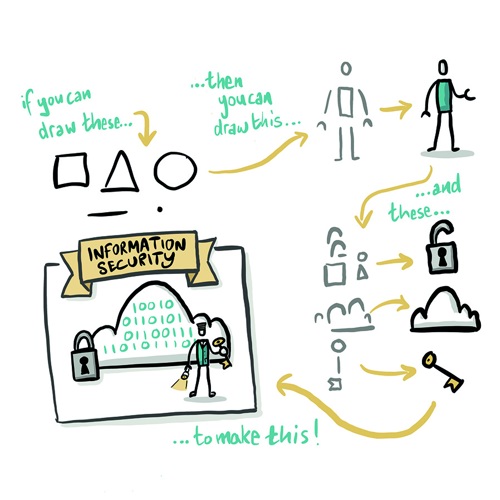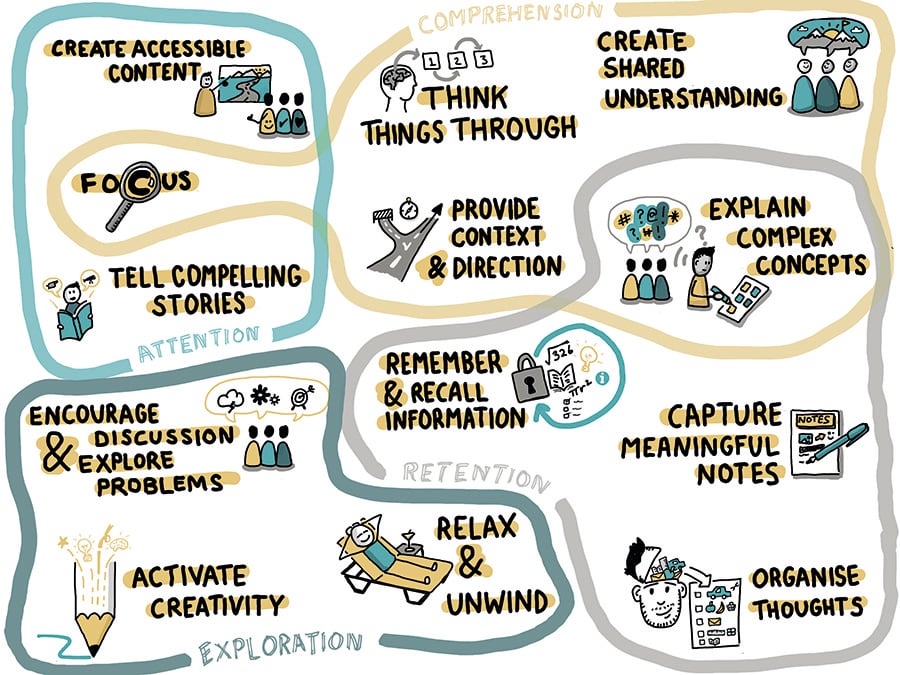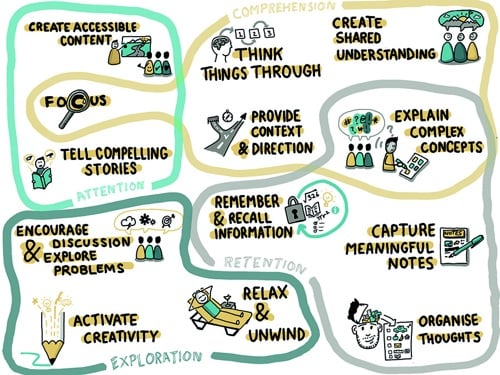Visual thinking opens up new possibilities that can take your business analysis practices to the next level, writes Grant Wright, Principal Consultant at Scarlett Solutions and co-founder of The Visual Jam.
Business analysis skills continue to be in demand from organisations seeking to deliver effective business change, but as the rate of change continues to increase exponentially, it begs the question: are traditional BA approaches alone enough?
Time for change?
Whilst business analysis remains a valued skill set, the more recent emergence of fields such as agile software development, design thinking and gamification have challenged the role of the traditional business analyst (BA) and their methods.
The term ‘business analyst’ conjures up an image of someone with a sequential, analytical mind with an emphasis on verbal documentation and technical models that are often abstract and geared towards ‘IT people’.
Now, whilst this description is probably a little stereotypical (and is certainly not a fair reflection of some of the fantastic BAs I have worked with throughout my career), it does perhaps highlight the need for BAs to think differently in order to explore problems, identify creative solutions and communicate in a way that is more engaging and accessible to others. This is where visual thinking comes in…
The power of visual thinking
In its simplest form, visual thinking is about seeing things in your mind’s eye and then externalising your thoughts in a visual way to aid understanding, explore problems and communicate more effectively.
The concept of visual thinking is not new: human beings are naturally visual creatures and some of the brightest minds in our history have used visuals to explore their thoughts and reimagine the world (think Leonardo DaVinci’s journals and inventions).
But, the application of visual thinking in a business context is still in its relative infancy. However, it has grown in popularity over the past decade or so, with authors such as Dan Roam, Mike Rohde, Willemien Brand and many others advocating the use of simple, hand-drawn visuals to help us stimulate conversation, create shared meaning and enhance our ability to retain and recall information.
Their methods vary, but all of these people share the belief that if you can draw simple shapes and stick figures, then you are capable of expressing yourself visually. As Mike Rohde says, it’s about ‘ideas, not art!’

Why visuals?
The benefits can be wide-ranging, depending on the context in which visual thinking is used, but in his book Visualeadership, Todd Cherches summarises three key areas: attention, comprehension and retention. I have also added a fourth one of my own: exploration (which creates a nice acronym - ACRE!).
- Attention: using visuals to grab and hold people’s attention or make content more accessible and easier to understand. For example, in the current climate we see a lot of simple visuals being used to help reinforce key messages about how to stay safe in a global pandemic.
- Comprehension: using visuals to externalise your thoughts and make connections that are much harder to see using your mind alone. It is said that if you cannot express something in a simple picture, then you do not truly understand it. Sketching out our understanding allows others to literally see what we are thinking, which results in a much richer conversation and invites others to validate our thoughts and fill in any gaps.
- Retention: visuals can also be used to help with learning in order to improve our ability to retain and recall information. In fact, there are a number of scientific studies that show that we are able to consume visual information more quickly and easily than the verbal equivalent. Furthermore, consuming information visually significantly increases our ability to accurately recall it at a later date.
- Exploration: visuals can also be used to help generate ideas and spark creativity. By externalising our thoughts, particularly in a group context, it changes the dynamic of the conversation, inviting different perspectives and allowing us to make connections that we may otherwise have missed. A lot of modern design thinking and customer / user experience (CX/UX) techniques fall into this category; these can be equally useful for BA practitioners.


Visual thinking for BAs
There are several ways in which visual thinking can be applied by BAs as well as people working in related disciplines such as business architects and agile product owners. Visual thinking can:
- enhance existing BA tools and techniques;
- open up new possibilities and expand the BA toolkit;
- amplify core BA skills and competencies such as communication, problem solving and critical thinking (and many more!);
- boost learning and professional development.
Let’s explore this further in the context of a BA’s role throughout the change delivery lifecycle.
Situation investigation and understanding
BAs are often involved early in the change lifecycle, perhaps at the pre-project stage, in order to investigate the current landscape and understand the problems that need to be solved from different perspectives. In this context, visuals are arguably essential to help make sense of the complexity of business systems and their interaction with their external environment.
There are several techniques from the world of systems thinking that are either already visual in nature, such as rich pictures or systems maps, or could be enhanced by combining them with other visual elements. For example, you could visualise a CATWOE analysis to bring to life different stakeholder perspectives, or add simple icons to a business activity model or a multiple cause diagram to make it easier to recognise the different elements and the relationships between them.
Analysing needs and defining requirements
Story maps, personas, empathy maps, customer journeys, experience maps and service design blueprints are all well-established visual techniques from the UX/CX community that BAs can leverage to better explore and understand stakeholder needs.
Visual thinking can also be applied to more traditional BA artefacts, such as use case models (let’s give those stick figures some personality!) or data models and state-transition diagrams (could we better illustrate what those abstract rectangles and lozenges actually represent?).
Explaining and embedding change
Visuals are also incredibly useful when explaining requirements or a proposed change to both technical and business stakeholders. A simple diagram to illustrate the complexity of a business rule to a developer, or a visual context diagram to help explain the implications of a change to end users, can make a huge difference in the quality of delivery and eventual adoption of the change.
Learning and self-development
Probably the biggest opportunity in the application of visual thinking for BAs is not so much in relation to specific BA artefacts or activities, but rather in how visual thinking can be used to amplify a BA’s core skills and competencies and to help them learn and develop.
Hand-drawn visuals can be added to presentations to help them stand out, become more accessible and give them a human touch (no more death by bullet point!). They can also be used in ‘heart to heart’ or ‘back of the napkin’ conversations to help build relationships, overcome objections and influence people. You can even use visual templates to help organise information (plans, projects, roadmaps, etc).
And finally, no article on visual thinking would be complete with mentioning Sketchnotes! Sketchnotes are a form of visual note-taking that combine simple drawings with text and typography in a way that makes content more engaging and easier to recall. They can be used to enhance your own meeting notes (which is a great place to get started) or distil the key points from books, conferences and training courses in a way that makes the information more digestible and memorable.
Your new BA super power
So now that you have had a glimpse into the possibilities that visual thinking offers why not take some time to explore this exciting topic further and unleash your new BA super power?

















